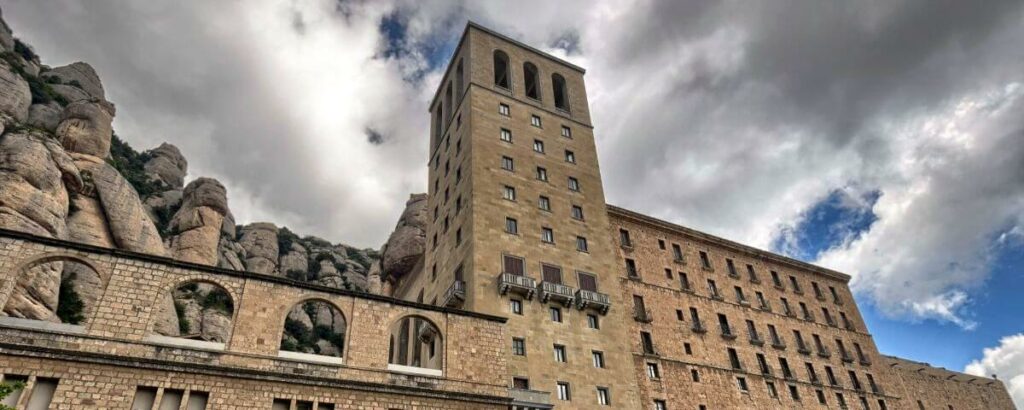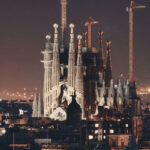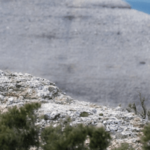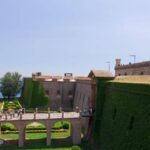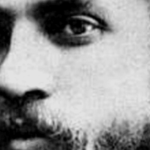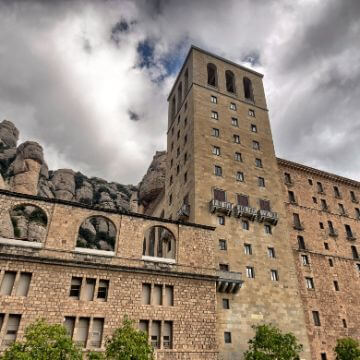
Fascinating Montserrat History
HISTORY OF A MOUNTAIN, MONASTERY AND MADONNA
Montserrat is much more than a monastery. Montserrat is a breathtaking rocky mountain just an hour outside of Barcelona. It’s the name of a Black Madonna that has been worshipped by the Catalans for over 1000 years. It’s the place where sings one of the oldest boys choirs in Europe. It’s what a Caribean Island is named after. It’s a natural park with. It’s a spiritual center that has been visited by religious leaders such as Saint Ignatius of Loyola, and the Pope Jean Paul II. It’s a historical enclosure that has been destroyed by Napoleon and rebuilt by Antoni Gaudi and his peers. It’s the second most visited pilgrimage center in Spain after Santiago de Compostela.
Very few places in the world have such an enthralling combination of historical events. In today’s post we want to take you on a trip through the centuries discovering the Montserrat Monastery history. Are you ready?
1
Geological history of Montserrat Mountain
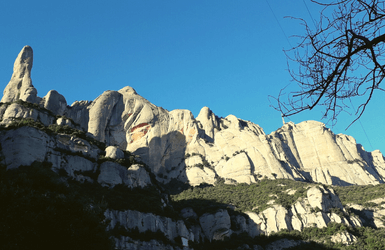
Our story starts 65 million years back in time, during the Secondary Era. The earth looked very different to what we see today. The center of Catalonia (Spain) was a sea, and here ended a huge river that for 30 millions of years carried sediments, pebbles and sand that accumulated on a delta. But the earth was slowly transforming: the continent that was crossed by the river started slowly sinking, and the bottom of the sea started rising. The pressure caused by these two opposite directions forced the materials of the delta to emerge, creating a massive ball of natural cement.
For the next 25 millions years, the action of the rain, wind and ice eroded and cracked this cement – geologically known as conglomerate. And little by little, the jagged forms of the Montserrat Mountain took shape. Either this, or the angels came down from heaven and with their golden saws they serrated a throne for the Virgin Mary, as the legend says. Why would it be called “Serrated Mountain” (Mont – mountain, Serrat – serrated), otherwise?
2
Origins of the Montserrat Monastery
The statue of the Virgin was still there when they arrived, and the priest decided to take it down to the closest town so it could be properly worshipped there. But as they started climbing her down she started getting heavier and heavier, until they couldn’t lift her up anymore. That’s when they understood that She was sending them a message: she wanted to stay in the mountain rather than be taken to the city.
The records say that it wouldn’t be until 8 years later, 888, when she was finally given a proper chapel attached to the outside of the cave (it’s the chapel of the Santa Cova, a short hike from the Montserrat Monastery). But only a century later the news about the miraculous Virgin had spread, and pilgrims where flocking there to see her. So the Abbott Oliva of Ripoll, one of the most powerful and influential characters of the Catalan Middle Ages, decided to found a monastery not far from the cave. It was 1025, and the history of the Montserrat Monastery started with a small community of benedictin monks that rivalled the nearby community of the Monastery of Saint Cecile, stablished in the mountain since 945.
3
Splendor of the Monastery of Montserrat
The following centuries are a period of splendor in the Montserrat history, even if politically the Catholic Monarchs would try to influence and control it importing monks from Castile and imposing Castilian abbots. The Montserrat friar Bernat de Boil travelled with Christopher Columbus on his second trip to America, and that’s how a Caribean Island was named after Montserrat. The Escolania choir, documented since 1307, reaches 20 members. The monastery also owned one of the first printing presses in Spain, in 1499, a huge achievement of the abbot Cisneros.
Giuliano della Rovere, later on Pope Jules II – the same that asked Michelangelo to paint the Sixtine Chapel, was an abbot of Montserrat as well, even if he managed the community from the distance and didn’t live in the mountain. He sponsored the construction of the monastery cloister. And in 1522 Saint Ignatius of Loyola arrived to Montserrat as a pilgrim, and after receiving confession and praying for an entire night in front of the Altar of the Montserrat Madonna he left his sword there, abandoning his military career for a spiritual life. One of the monks of Montserrat, father Joan Chanon, was his confessor and religious mentor.
4
Destruction and reconstruction
In 1808 the French tried to get hold of the mountain, despite managing to set the monastery in fire, they fell into a trap organized by the local militia led by a man playing a drum – the famous Timbaler del Bruc. Over 400 French soldiers were killed in that first battle. But by 1811 the French army had managed to conquer the Catalan territory except for 3 sites – one of them Montserrat.
The French General Suchet was decided to not make a fool of himself again. He gathered an army of 10.000 men and organized them in 5 different divisions to attack the monastery from different sides. Superior in training and equipment, the French troops managed to take the monastery by surprise, killing 400 Spanish fighters while the French only lost about 200. The monastery of Montserrat was then sacked and set in fire again. In the end, though, Napoleon and his brother would only dominate Spain until 1813, when they had no other option but to sign a peace treaty and give the crown back to the legitimate king Ferdinand VII.
After the king passed away, his widow Maria Cristina became the regent, and her Minister of Finances Mr. Mendizabal signed the famous law of Desamortizaciones, expropriating the assets of the Catholic Church, and that included the ruins of the Monastery of Montserrat, that was abandoned. However, only a few years later, in 1844 the community of monks of Montserrat regrouped and came back to the monastery. The Castilian community that had controlled the Catalan monks in the middle ages had stopped existing, so the Montserrat Monastery was again independent from outside influences.
In 1858 the abbot Muntadas promotes the restoration of the monastery, and in 1862 he reorganizes the Escolania choir that had been dismantled after the Napoleonic attacks. Barcelona is living a golden period with the demolition of the city walls and the wealth generated by the Industrial Revolution. At the same time there’s a cultural revival known as Renaixença, from which will stem the Catalan Modernisme.
The recovery of the Monastery of Montserrat becomes a symbol of the Catalan patriotism. The renowned architect Puig i Cadafalch built a neoromanesque cloister, and Francesc de Paula i Villar rebuilt the basilica, which was profusely decorated by top artists of the time. And even a young Antoni Gaudi participated decorating one of the stations of the cross that adorned the path to the Santa Cova Chapel. In 1880 is presented the official anthem of Montserrat: the Virolai song, and in 1881 the Pope Leo XIII declared our Lady of Montserrat the patron saint of Catalonia. In 1892 is inaugurated the cog wheel train to the Monastery.
In 1918 would come the first funicular now known as Funicular de Sant Joan. The funicular of the Santa Cova came in 1929, and in 1930 were opened two cable cars (one of them discontinued in 1930). Parallelly, the monastery hosts liturgy congresses and increases their cultural activities in the history, bibliography and music fields. At the same time, the dictator Primo de Rivera prohibits Catalan symbols, signs and gatherings in Montserrat, as the monks were suspicious of promoting Catalan separatist ideas.
5
Spanish Civil War and Franco's Dictatorship
The monks proceeded to hide artwork and other valuable items behind fake walls and secret chambers or sent to the homes of neighbors they trusted. The statue of the Virgin of Montserrat was swapped by a copy. The abbot Marcet, then, arranged the evacuation of the 150 members of the community. Many of them managed to board ships and leave for the exile, some ended up working for the fascist army as soldiers or military priests, but 23 of them were arrested and executed.
In the meantime, the Catalan government assigns people to maintain the enclosure of the Monastery of Montserrat and keep the restaurants and other services there open. The president of the Republic, Manuel Azaña, and the president of the Catalan Government Lluis Companys would live there for a while, and even organized there a meeting of the republican courts. The Montserrat monastery also served a military hospital during the war, equipped with some 3000 beds.
6
Franco's Dictatorship
When Marcet retired, he was substituted by the abbot Escarre, an ambiguous character that in one was in good terms with Franco for his support to the Catholic church, but also allowed Montserrat to become a pole of Catalan nationalism – which was opposite to Franco’s ideas. He instilled a feeling of unity among the community of monks, many of them arriving from other areas of Spain. And he promoted construction works of new areas of the monastery as well as expanded the monastery art collection. In 1947 a new throne for the Madonna of Montserrat was paid out of donations.
In 1953 a tragic cogwheel train accident killed 8 people and caused many injured, and as a result the train service was discontinued. In 1959 Franco visited the abbot Escarre after some political events where the Catalan language and the people that used it had been severely criticized by the Spanish media and authorities. Escarre was not happy, and after that moment on he started more openly supporting Catalan activists. His relationship with Franco suffered from it, and he was forced to leave Montserrat and go serve in the Vatican, from where he would never be allowed to return.
After Escarre came the abbot Brasó, who continued supporting the Catalan resistance. His influence in the Vatican of Pope Paul VI was crucial to approve that the bishops in Catalonia would be Catalan people, not from other areas of Spain. And he also managed to remove the hierarchical differences between ordained and non-ordained monks at the monastery, to strengthen the unity within the community. And he refused to receive Franco during his visit to the Montserrat Monastery in 1966.
Being abbot Cassia M. Just and with his blessing, in 1970 300 Catalan intellectuals locked themselves in the monastery to protest against the dictatorship and claim for the respect of human rights. They were sieged by the police for 2 days. The participants were punished with high fines, interdiction of performing in public, passport removal… However the action attracted the international attention and was key to force to stop some death sentences. Cassia M. Just also positioned himself in favor of other protests against Franco and criticized the Church ideas against contraceptives, euthanasia and homosexuality.
7
The Montserrat Monastery nowadays
In 1986 a wild fire burnt the area near the Santa Cova chapel, endangering it and the monk in charge of it. The next year the Catalan government declared Montserrat a Natural Park to ensure its protection. However another wildfire, very likely intentionally set, burnt a huge portion of the mountain again in 1994. Flooding caused lots of damages in the mountain and the monastery area in 1995 and 2000. On 2003 the cogwheel train service was reestablished with modern vehicles.
Howadays the Montserrat monastery is the home of a community of some 80 monks and the 50 kids of the Escolania Choir. The monks continue to be very involved in the political and cultural live of Catalonia, running their own printing house. The mountain is visited by over 2.5 million people every (non-pandemic) year. When will you come visiting?
I hope you found the history of Montserrat as fascinating as we do!
Marta
RESEARCHING FOR A TRIP IS TIME-CONSUMING…
Need more inspiration?
Our 100% FREE Barcelona Collection will give you everything you need to organize the trip of your lifetime to Barcelona.
BEST INSIDER TIPS FROM THE PROS!

Last update on 2024-04-18 / Affiliate links / Images from Amazon Product Advertising API

